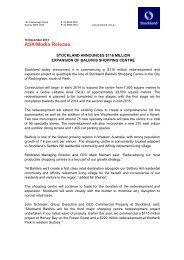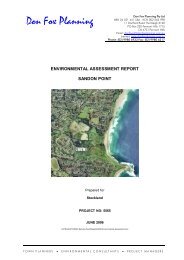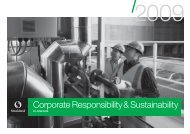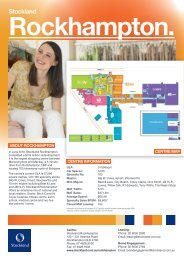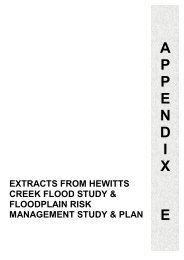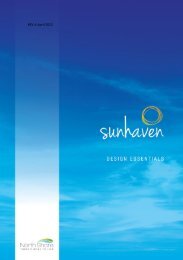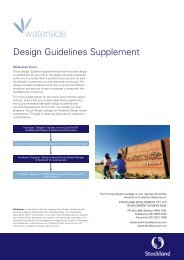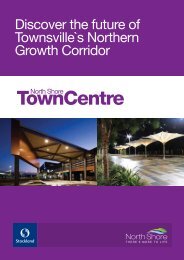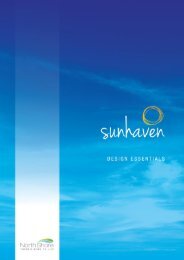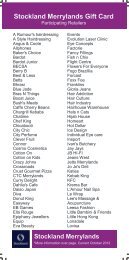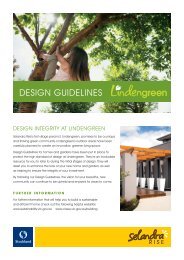Download PDF - Stockland
Download PDF - Stockland
Download PDF - Stockland
Create successful ePaper yourself
Turn your PDF publications into a flip-book with our unique Google optimized e-Paper software.
We will continue to strive for leadership<br />
through innovations in our projects, such<br />
as the incubation of low carbon and<br />
renewable energy supply and generation<br />
solutions. In FY11 we will develop a<br />
Distributed Energy strategy setting out a<br />
pathway for low carbon and renewable<br />
energy (also known as distributed<br />
generation). Our approach is to pilot<br />
and then implement successful projects<br />
at scale, achieving long-term efficiencies.<br />
Communicate: Effectively<br />
communicate our position<br />
and performance.<br />
We have already undertaken a significant<br />
amount of work in the area of climate<br />
change. We engage with all levels of<br />
government and our peers to share our<br />
learnings and partner in research projects.<br />
We also engage with environmental,<br />
social and governance analysts and<br />
participate in the development of a global<br />
common carbon metric for property. This<br />
engagement and communication process<br />
ensures that our prioritisation, reporting<br />
and management of our climate change<br />
response remains relevant.<br />
In FY11 we will work on improving our<br />
communications, making our response<br />
to climate change risk clearer to our key<br />
stakeholder groups.<br />
Energy Efficiency<br />
Over the past year we have continued to<br />
improve how we set and monitor energy<br />
efficiency and emissions targets for each<br />
of our businesses. We have undertaken<br />
a number of energy efficiency projects<br />
and have set minimum standards for<br />
energy efficiency in our operations<br />
and developments.<br />
Commercial Property energy efficiency<br />
Despite difficult economic conditions, we<br />
have continued to manage our greenhouse<br />
gas emissions and increase our capability<br />
in improving energy efficiency within<br />
existing and new buildings. We have also<br />
improved our evaluation of low carbon and<br />
measurable energy solutions.<br />
Using the NABERS Energy rating tool<br />
to benchmark building performance, we<br />
are improving energy efficiency through<br />
capital investment in high-efficiency<br />
chillers, building management systems,<br />
lighting controls and variable speed drives.<br />
Once again we were awarded a number of<br />
grants through the Federal Government’s<br />
‘Green Building Fund’ to implement<br />
initiatives across our office portfolio and<br />
commenced a trial of energy sub-metering<br />
in several shopping centres.<br />
Last year we committed to a NABERS<br />
Office Energy portfolio average rating of<br />
4.5 Stars by FY14. In FY10 we achieved<br />
an office portfolio average of 3.6 Stars. The<br />
NABERS Retail Energy and Water rating<br />
tools were released in early 2010. We have<br />
since prepared ratings for two shopping<br />
centres. We have received confirmation<br />
that our Forster Shopping Centre has<br />
been awarded the 5 Stars NABERS Retail<br />
Energy rating. We will undertake further<br />
NABERS Retail ratings during FY11.<br />
average<br />
nabers<br />
office<br />
energy<br />
rating<br />
3.6 stars<br />
2009<br />
3.6<br />
Average NABERS office energy rating (stars)<br />
2008<br />
2007<br />
2006<br />
2005 2.5<br />
2.9<br />
2.9<br />
3.4<br />
Energy intensity targets are set for the<br />
whole Commercial Property portfolio.<br />
Last year we committed to a 20 per cent<br />
reduction on FY09 figures by FY14. This<br />
target complements our NABERS target<br />
of an average office rating of 4.5 Stars over<br />
the same timeframe, and our commitment<br />
to undertaking Green Star ratings for<br />
development projects.<br />
This year we have had mixed energy<br />
intensity results. The electricity intensity of<br />
our retail centres increased by 4 per cent,<br />
while the electricity intensity of our office<br />
assets (where we have operational control)<br />
was reduced by 5 per cent. While we<br />
are disappointed in the increase in the<br />
intensity from our retail centres, we expect<br />
that embedding minimum standards<br />
for energy efficiency, and training our<br />
retailers on energy efficiency and capital<br />
expenditure on sustainability, will improve<br />
energy efficiency across our retail centres<br />
over the coming year.<br />
Residential energy efficiency<br />
Our Residential business collects energy<br />
data from direct operations and those<br />
undertaken by contractors on-site. This<br />
data is being used to better understand<br />
energy and emissions source and type<br />
and will be incorporated in our energyefficiency<br />
targets by FY12. The majority of<br />
energy use and emissions is associated<br />
with diesel consumed by the heavy<br />
machinery used by civil contractors and<br />
landscapers and this presents a significant<br />
challenge for efficiency improvements.<br />
We have set requirements for energy<br />
efficiency and management in our<br />
Residential sustainability policy and this<br />
includes requirements for all projects to:<br />
• Co-locate services (in a single trench)<br />
to reduce excavation efforts,<br />
• Maximise beneficial solar orientation<br />
of lots,<br />
• Connect dwellings and other buildings<br />
to reticulated natural gas or LPG<br />
where available,<br />
• Provide energy-efficient lighting in<br />
public domain/areas,<br />
• Use or require energy-efficient<br />
hot water systems such as<br />
gas-boosted solar.<br />
In addition, we are building the capability of<br />
Residential employees in energy generation<br />
and management. For example, some<br />
employees participated in a workshop on<br />
distributed energy with CSIRO to explore<br />
opportunities for energy generation and<br />
distribution in our developments.<br />
We are now collecting data related to the<br />
average Nationwide House Energy Rating<br />
Scheme (NatHERS) ratings achieved by<br />
homes being built in our display villages<br />
or as a result of our partnerships with<br />
builders. The NatHERS star rating system<br />
refers to the thermal performance of the<br />
building’s shell.<br />
Retirement Living<br />
The Retirement Living sustainability<br />
policy includes requirements for energy<br />
efficiency and management. In FY10,<br />
an energy infrastructure and usage audit<br />
was conducted in this business unit. We<br />
will use the results of this audit to identify<br />
energy efficiency and saving initiatives in<br />
existing villages and inform the design of<br />
product in future villages.<br />
An important aspect of energy efficiency<br />
and emissions for the Retirement Living<br />
business is how residents access and<br />
use energy. In FY10 we worked with a<br />
solar company to provide discounted<br />
solar panels and helped residents<br />
access government rebates.<br />
<strong>Stockland</strong> Corporate Responsibility & Sustainability Report June 2010<br />
77



